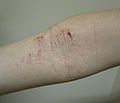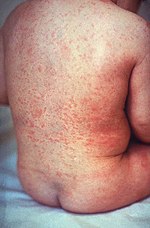Staphylococcus capitis is a coagulase-negative species (CoNS) of Staphylococcus. It is part of the normal flora of the skin of the human scalp, face,...
16 KB (1,973 words) - 05:31, 11 August 2024
of them, staphylococcus bacteria stay present in hospitals, where they can infect people who are most at risk of infection. Staphylococcus includes at...
27 KB (2,812 words) - 05:51, 29 October 2024
Descriptions of Four New Species: Staphylococcus warneri, Staphylococcus capitis, Staphylococcus hominis, and Staphylococcus simulans". International Journal...
1 KB (84 words) - 22:49, 20 November 2024
Dandruff (redirect from Pityriasis capitis)
belonged to P. acne, and 94.9% of the Staphylococcus were Staphylococcus spp (including S. epidermidis, S. capitis and S. caprae). It was found that Propionibacterium...
23 KB (2,205 words) - 09:35, 21 October 2024
Descriptions of Four New Species: Staphylococcus warneri, Staphylococcus capitis, Staphylococcus hominis, and Staphylococcus simulans". International Journal...
5 KB (542 words) - 15:18, 15 February 2023
Staphylococcus hominis is a coagulase-negative member of the bacterial genus Staphylococcus, consisting of Gram-positive, spherical cells in clusters...
16 KB (1,905 words) - 19:02, 17 May 2024
strains are resistant to chloramphenicol. Some Veillonella spp. and Staphylococcus capitis strains have also developed resistance to chloramphenicol to varying...
48 KB (4,779 words) - 20:32, 22 November 2024
painful or itchy. Fever is uncommon. It is typically due to either Staphylococcus aureus or Streptococcus pyogenes. Risk factors include attending day...
21 KB (1,938 words) - 00:54, 19 October 2024
the most common cause, particularly Staphylococcus aureus. The more invasive methicillin-resistant Staphylococcus aureus (MRSA) may also be a source of...
33 KB (3,315 words) - 17:31, 22 November 2024
completely clear the condition when Staphylococcus aureus bacteria are found. Fungal infections such as tinea capitis are known to mimic the symptoms of...
4 KB (389 words) - 09:54, 27 July 2022
most commonly infected with tinea capitis. Trichophyton tonsurans is the most common cause of out breaks of tinea capitis in children, and is the main cause...
23 KB (2,898 words) - 13:04, 26 July 2024
leading to disruption of skin flora and bacterial overgrowth (commonly Staphylococcus aureus overgrowth or colonization). AD is also associated with the release...
91 KB (9,485 words) - 15:09, 22 November 2024
the case. The bacteria most commonly involved are streptococci and Staphylococcus aureus. In contrast to cellulitis, erysipelas is a bacterial infection...
31 KB (3,286 words) - 00:54, 14 October 2024
carbuncles, boils, and other cases of folliculitis are infected with Staphylococcus aureus. Folliculitis starts with the introduction of a skin pathogen...
8 KB (749 words) - 18:24, 2 April 2024
follicle. It is most commonly caused by infection by the bacterium Staphylococcus aureus, resulting in a painful swollen area on the skin caused by an...
13 KB (1,310 words) - 18:19, 26 July 2024
listed below. Atopic dermatitis (eczema) Contact dermatitis Psoriasis Tinea capitis and tinea corporis Candidiasis Tinea versicolor Pityriasis rosea Impetigo...
35 KB (3,434 words) - 08:05, 24 November 2024
fungi. Its sudden (acute) occurrence is usually due to the bacterium Staphylococcus aureus. Gradual (chronic) occurrences are typically caused by fungi...
14 KB (1,475 words) - 16:50, 22 October 2024
tinea: tinea corporis, tinea gladiatorum, tinea cruris, tinea pedis, tinea capitis, and tinea unguium (e.g., onychomycosis).) Cutaneous infections caused...
10 KB (783 words) - 16:34, 29 October 2024
strep throat, and may be worsened by skin or gut colonization with Staphylococcus aureus, Malassezia spp., and Candida albicans. Guttate psoriasis often...
116 KB (13,061 words) - 15:20, 6 November 2024
described in 1900 and is postulated to be related to the bacterium Staphylococcus aureus. In 1979 and 2001 a possible "seventh disease" was postulated...
8 KB (574 words) - 18:54, 22 October 2024
Neisseria meningitidis, Mycobacterium, Pneumococcus, Salmonella species, Staphylococcus species, Mycoplasma pneumoniae), chlamydial. Fungal (Coccidioides immitis)...
9 KB (749 words) - 19:13, 8 September 2024
light), although useful in diagnosing fungal infections of the scalp (tinea capitis), is not usually helpful in diagnosing athlete's foot, since the common...
37 KB (4,083 words) - 16:41, 13 November 2024
Bertholet, S.; Grandi, G. (2012). "Inferring Reasons for the Failure of Staphylococcus aureus Vaccines in Clinical Trials". Frontiers in Cellular and Infection...
55 KB (1,669 words) - 07:51, 17 November 2024
sweat glands become clogged due to dead skin cells or bacteria such as Staphylococcus epidermidis, a common bacterium that occurs on the skin, which is also...
13 KB (1,539 words) - 03:50, 6 October 2024
responsible for about 20% of cases, mixed infection of C. albicans and Staphylococcus aureus for about 60% of cases. Median rhomboid glossitis Candidal vulvovaginitis...
67 KB (6,467 words) - 10:00, 25 November 2024
and the symptoms presentation. Purulent cellulitis is often caused by Staphylococcus aureus, including both methicillin-sensitive (MSSA) and methicillin-resistant...
22 KB (2,101 words) - 11:32, 7 September 2023
look like erythema toxicum neonatorum. Bacterial infections, including Staphylococcus and Streptococcus infections, almost always cause additional symptoms...
12 KB (1,313 words) - 20:21, 14 November 2024
formation. Along with the bacteria C. acnes, the bacterial species Staphylococcus epidermidis (S. epidermidis) also takes a part in the physiopathology...
166 KB (17,978 words) - 06:42, 20 November 2024
Bacterial overgrowth can produce an odour. The main bacteria is epidermal Staphylococcus aureus. The main viruses are human papillomavirus (HPV) and herpes simplex...
26 KB (3,038 words) - 15:14, 6 September 2024






















